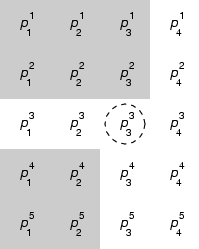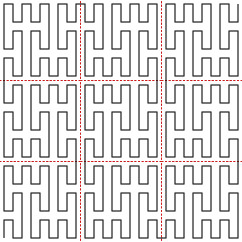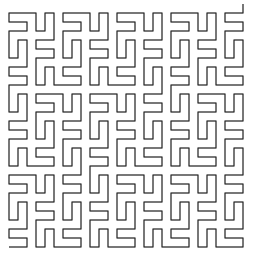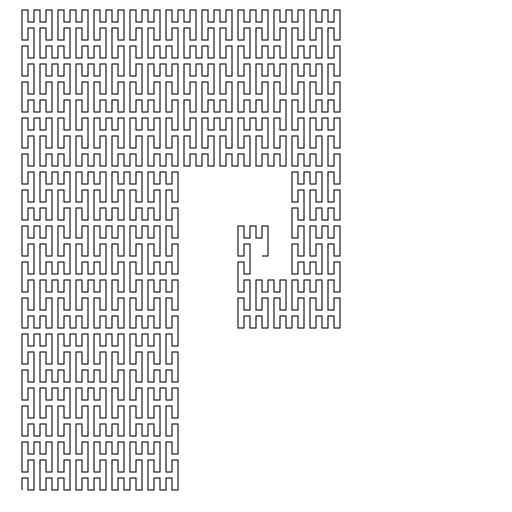A space-filling curve
is a parameterized function which maps a unit line segment to a
continuous curve in the unit square, cube, hypercube, etc, which gets
arbitrarily close to a given point in the unit cube as the parameter
increases.
Space-filling curves serve as a counterexample to less-than-rigorous
notions of dimension.
In addition to their mathematical importance, space-filling curves
have applications to
dimension reduction,
mathematical programming [Butz 1968],
multi-dimensional database indexing [Lawder 2000], and
radio-frequency electronics [Zhu 2003].
The space-filling constructions are usually designed to map between
the real unit line segment and the unit n-cube. My interest is
to expand their range to the entirety of n-space.

The Algorithm
In Space filling curves and
mathematical programming Butz gives an algorithm for
computing the Peano space-filling curve in terms of the base-3
representation of coordinates between 1 and 0. The grid shown to the
right has m columns of (rank) n digits, each row
corresponding to one spatial coordinate. The leftmost digits are the
most significant, the ternary-point lying to their left.
Digit i of row j, pji,
is replaced by 2-pji
if the integer sum of:
- all the digits in columns left of column j which are not in
row i and
- the digits in column j above row i
is odd.
The area around digits contributing to this sum for the circled
p33
is shaded in the figure.
Notice that the parity (zero vs. nonzero) of digit
pji
remains unchanged when it is replaced by
2-pji.
Thus the order of processing digits is arbitrary.
This peano-flip! operation is its own inverse.
A naive implementation would take time
O(mn2) for the complete table.
By scanning down each column from left to right while calculating the
total parity and the parity for the portion of each row already
visited, this can be reduced to O(mn).
Here is the simplest case. Groups of flipped digits are underlined.
| scalar
| 0
| 1
| 2
| 3
| 4
| 5
| 6
| 7
| 8
|
|---|
| digits
|
|
|
|
|
|
|
|
|
|
|---|
| flipped
|
|
|
|
|
|
|
|
|
|
|---|
So within a 3*3 cell an odd higher digit flips the lower digit,
creating the signature S curve.
| scalar
| 9
| 10
| 11
| 12
| 13
| 14
| 15
| 16
| 17
| 18
| 19
| 20
| 21
| 22
| 23
| 24
| 25
| 26
| 27
|
|---|
| digits
|
|
|
|
|
|
|
|
|
|
|
|
|
|
|
|
|
|
|
|
|---|
| flipped
|
|
|
|
|
|
|
|
|
|
|
|
|
|
|
|
|
|
|
|
|---|
From 0 to 8 we have seen digits increment or decrement only by 1.
From 8 to 9, 17 to 18, and 26 to 27 the low order digit jumps from 2
to 0 while carrying into the digit to its left.

The Curve
What results is a curve with a high degree of self-similarity. Each
square is composed of 9 squares; 5 of which connect bottom left to top
right and 4 of which connect bottom right to top left.
The horizontal segments in the curve at right are all the same length.
Vertical segments, however, are two and five times the horizontal
length.
Long straight segments degrade the closeness-preserving properties
important to many applications. Where a linear distance of 5 units
may map to an n-space distance of 5 in this curve, in a
wigglier curve it would always map to a shorter distance.
This suggests that a figure-of-merit for space-filling curves would be
to sum, for every pair of m-digit points in n-space, the
ratio of the euclidean distance to its corresponding linear distance.
The Performance of Space-Filling Curves
for Dimension Reduction reports the results of such measurements.

Wigglier
Each 2-dimensional cell connecting either bottom-left-to-top-right or
bottom-right-to-top-left suggests a method for making the curve
wigglier: swap x and y coordinates for all the
bottom-left-to-top-right cells.
Generalizing this to higher ranks is not straightforward. Each
3-dimensional cell connects along one of three diagonals of the cube.
Centering
The transforms outlined above can be easily generalized to cover
nonnegative coordinates of arbitrary size by moving the ternary-point
to the right. Furthermore, the precision to calculate and
ternary-point position can be determined when the function is called
based on the magnitude of its arguments.
Also useful would be a space-filling curve covering all integer
coordinates, Zn. Although each
3mn point curve is symmetrical
around its center, the coordinates calculated by the algorithm given
above are nonnegative. Although the conversion from the digit table
to n-space coordinates could subtract one from each digit;
because the number of digits is autoscaled, discontinuities result
at 3mn boundaries.
More fundamental is that, if all of n-space is to be covered by
a double-ended self-similar curve, then negative linear numbers must
paint half of it. Thus the positive half of linear numbers in the
range -3mn/2 to 3mn/2 must paint a shape other than a
square. Fortunately, they form what could be described as a
rectilinear spiral:
The algorithm to convert from an integer scalar to
n centered Peano coordinates is:
- Find the smallest m such that
9mn/2 is greater or equal to
absolute-value of scalar;
- Convert scalar + 9mn/2
into a ternary digit array;
peano-flip! the ternay digit array;
- extract each coordinate from its array row; offsetting it by
-9m/2.
The algorithm to convert from n centered Peano coordinates to
an integer scalar is:
- Find the smallest m such that
9m/2 is greater or equal to
the absolute-value of each the input coordinate.
- Convert the coordinates offset by
+9m/2
into a ternary digit array;
peano-flip! the ternay digit array;
- extract the scalar from the array; offsetting it by
-9mn/2.
The divisions all round toward zero. The base of the exponents is 9
rather than 3 because, although the center square of the
3m scale
cube has the same orientation as the corner squares, it is traversed
in the reverse direction.
Praxis
slib/peanosfc.scm
is a Scheme implementation of Peano conversions between integer
scalars and integer coordinate vectors of arbitrary size.
- Function: natural->peano-coordinates scalar rank
-
Returns a list of rank nonnegative integer coordinates corresponding
to exact nonnegative integer scalar. The lists returned by natural->peano-coordinates for scalar
arguments 0 and 1 will differ in the first element.
- Function: peano-coordinates->natural coords
-
Returns an exact nonnegative integer corresponding to coords, a list of
nonnegative integer coordinates.
- Function: integer->peano-coordinates scalar rank
-
Returns a list of rank integer coordinates corresponding to exact
integer scalar. The lists returned by integer->peano-coordinates for scalar arguments 0 and 1 will
differ in the first element.
- Function: peano-coordinates->integer coords
-
Returns an exact integer corresponding to coords, a list of integer
coordinates.
Further Work
- Develop a "wigglier" variant of the Peano curve.
The Peano curve described here does not have the isotropy property
called for by Multidimensional
Space-Filling Curves:
the lengths of axis-aligned projections of the space-filling curve
should be equal.
The Peano curve reflects cells in order to make them contiguous,
but does not perform the rotation causing such vexation in
Recursive Formulation of Multidimensional
Space-Filling Functions
It should be possible to rotate those cells currently subject to
an odd number of reflections. That would rotate 4 of the 9
subcells of each cell.
- Write comparison functions for Peano fixed-point coordinates.
- Write comparison functions for Peano floating-point coordinates.
- Use these functions to extend the WB
B-trees to multidimensional indexes a la
[Lawder 2000].
Copyright © 2005, 2006 Aubrey Jaffer
I am a guest and not a member of the MIT Computer Science and Artificial Intelligence Laboratory.
My actions and comments do not reflect in any way on MIT.
|
| | Space-Filling Curves
|
| agj @ alum.mit.edu
| Go Figure!
|





